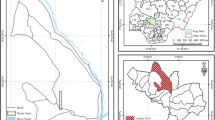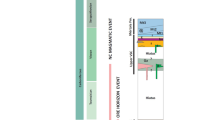Abstract
Our study interprets large-scale gravity data to delineate concealed banded iron formation (BIF) iron mineralization in India's Rajasthan province. The study area belongs to the Bharatpur, Dausa, and Karauli districts of Rajasthan. We measured 1462 gravity readings to understand the rock types, depth and geometry of the different rock formations in the proposed study area. We also collected representative lithologies from more than 100 locations in the study area and calculated their density values. The measured gravity datasets are investigated via qualitative (e.g., Bouguer anomaly, first derivative and second derivative) and quantitative (radially averaged power spectrum, 3D Euler deconvolution, and 3D inversion) approach. The qualitative methods suggest a general NE–SW orientation of the BIFs, controlled by the general trend of the study area's structural setting. The lithological contact between the Bhilwara and Vindhyan Supergroups is demarcated by a NE–SW trending steep gravity gradient zone. In this area, representative lithologies yield high densities (about 3.746 gm/cc), and the samples identified as BIF represent exploration targets for iron ore. We have also developed our own in-house 3D gravity inversion code in this study. A model space inversion algorithm is converted into a data space using the identity relationship. It makes inversion algorithm very user-friendly on conventional desktop computers. The outcomes from the 3D inversion suggest that the concealed iron ore thickens to the west. This interpretation is also in good correlation with Euler 3D deconvolution of the gravity data.

Source: Geodata Division, GSI, WR)











Similar content being viewed by others
References
Alvandi, A., & Asil, R. H. (2014). Edge detection process of Qom salt dome gravity anomalies using hyperbolic tilt angle. International Journal of Geomatics and Geosciences, 5(2), 209–224.
Bakliwal, P.C. (1975). Geology of Bandawal-Maridawar-Mahuwa area, Alwar, Jaipur and Sawai- madhopur districts, Rajasthan. Unpublished GSI Prog. Report, (1973–1974).
Bhattacharya, N.B. (1969). Geology of Toda Bhim, Gijgarh area, Jaipur and Sawai Madhopur districts, Rajasthan. Unpublished GSI Report, (F.S. 1967–1968).
Biswas, A., & Sharma, S. P. (2016). Integrated geophysical studies to elicit the structure associated with Uranium mineralization around South Purulia Shear Zone, India: A Review. Ore Geology Reviews, 72, 1307–1326.
Blakely, R. J. (1996). Potential theory in gravity and magnetic applications. Cambridge University Press.
Chakrabarthy, C., & Bhattacharyya, A. (1996). The Vindhyan basin: an overview in the light of current perspectives, In: Bhattacharya, A., (ed.) Recent advances in Vindhyan geology. Geological Society of India Memoir vol. 36, pp. 301–312.
Chandak, G.J. (1965). Investigation of the Talc deposits in Morra Ka Dunger ridge, Sawai Madhopur district, Rajasthan. Unpublished GSI Prog. Report, (F.S. 1964–1965).
Chandak, G. J., & Gupta, C.L. (1967). Investigation of the Lakhauli talc deposits, district Udaipur, Rajasthan (F.S. 1965–66).
Chandak, G.J., & Bhattacharya, N.B. (1971). A report on the investigation of the Nagria and Gaglatalc deposits, district Udaipur, Rajasthan (F.S. 1966–1967).
Eaton, B. Milkereit, & MH Salisbury. (2003). Society of Exploration Geophysicists, Tulsa, Okla, pp. 20–42.
Fitzgerald, D., Reid A., & McInerney, P. (2003). New discrimination techniques for Euler deconvolution: 8th SAGA Biennial Technical Meeting and Exhibition, 7–10.
Geological Survey of India (GSI), Standard Operating Procedures (SOP). (2011). A manual on SOP in mineral exploration (Mission II- A natural non- energy resource assessment): www.portal.gsi.gov.in/gsiDoc/pub/draft_sop_minex.pdf, Accessed in May, 2013.
Goodway, B. (2012). Introduction to this special section: Mining geophysics. The Leading Edge, 31(3), 288–290.
Guha, D.B., & Rai Choudhary A. (1996). Report on the detailed study along Great Boundary Fault in Sawai Madhopur sector, Sawai Madhopur, Tonk and Kota districts, Rajasthan (F.S.1994–1995).
Gupta, G. P. (1989). Transect geology of the north Delhi fold belt. Unpublished GSI Report, (F.S. 1987–88).
Hacket, C. A. (1877). Note on Aravalli series in northeastern Rajputana. Records of the Geological Survey of India, 10(2), 2.
Hacket, C. A. (1881). On the geology of the Aravalli region, central and eastern. Records of the Geological Survey of India, 14(4), 297–303.
Heron, A. M. (1953). The geology of central Rajputana. Memoirs of the Geological Survey of India, 79, 1–389.
Heron, A. M. (1917). Geology of Northeastern Rajputana and adjacent districts. Memoirs of the Geological Survey of India, 45(1), 128.
Kesler, S.E. (2007). Mineral supply and demand into the 21st century. In proceedings for a work-shop on deposit modeling, mineral resource assessment, and their role in sustainable development. US Geological Survey circular Vol. 1294, pp. 55–62.
Kumar, A., & Rakshit, P. (2011a). Geology and mineral resources of Rajasthan. Geological Society of India, 30(12), 7–9.
Kumar, A., & Rakshit, P. (2011b). Geology and mineral resources of Rajasthan. Geological Society of India, 30(12), 26–28.
Li, Y., & Oldenburg, D. W. (1998). 3-D inversion of gravity data. Geophysics, 63(1), 109–119.
Li, Y., & Oldenburg, D. W. (2003). Fast inversion of large-scale magnetic data using wavelet transforms and a logarithmic barrier method. Geophysical Journal International, 152(2), 251–265.
Mandal, A., Mohanty, W.K., & Sharma, S.P. (2013). 3D compact inverse modeling of gravity Data for chromite exploration—A case study from Tangarparha, Odisha, India. In SEG Technical Program Expanded Abstracts 2013 (1171–1174). Society of Exploration Geophysicists.
Mandal, A., Mohanty, W. K., Sharma, S. P., Biswas, A., Sen, J., & Bhatt, A. K. (2015). Geophysical signatures of uranium Bengal, India: A case mineralization and its subsurface validation at Beldih, Purulia District, West study. Geophysical Prospecting, 63, 713–726.
Maus, S., & Dimri, V. (1996). Depth estimation from scaling power spectrum of potential fields. Geophysical Journal International, 124, 113–120.
Naidu, P. S., & Mathew, M. P. (1988). Computer program for radial and angular spectrum estimation (pp. 1–11). Unpublished Report.
Naskar, D. C., & Kulkarni, A. V. (2019). Geophysical investigation for copper and gold mineralization around Dhani-Basri and Todika Bas area, Dausa and Alwar districts, Rajasthan. Journal of Indian Geophysical Union, 23(2), 120–133.
Oldenburg, D.W., & Pratt, D.A. (2007). Geophysical inversion for mineral exploration: a decade of progress in theory and practice. In Proceedings of exploration vol. 7, no. 5, pp. 61–95.
Pilkington, M. (2009). 3D magnetic data-space inversion with sparseness constraints. Geophysics, 74(1), L7–L15.
Prasad Rajendra, B., & Vijaya Rao, V. (2006). Deep seismic reflection study over the Vindhyans of Rajasthan: Implications for geophysical setting of the basin. Journal of Earth System Science, 115(1), 135–147.
Qureshy, M.N., Subba Rao, D.V., Bhatia, S.C., Aravamadhu, P.S., & Subrahmanyam, C. (1973).Gravity bases established in India by N.G.R.I. – Part IV: Geophysical Research Bulletin, vol. 11, no. 2, pp. 136–152.
Raja Rao, C.S., Poddar, B.C., & Mathur, R.K. (1969). Interim report on the exploration for zinc-lead deposit at Rajpura-Dariba, Udaipur district, Rajasthan (F.S. 1966–1968).
Ram, J., Shukla, S. N., Pramanik, A. G., Varma, B. K., Chandra, G., & Murthy, M. S. N. (1996). Recent investigations in the Vindhyan basin: implications for the basin tectonics. Memoir Geological Society of India, 36, 267–286.
Raza, M., & Casshyap, S. M. (1996). A tectono-sedimentary model of evolution of middle Proterozoic Vindhyan basin. Memoir Geological Society of India, 36, 287–300.
Roach, M. J., Leaman, D. E., & Richardson, R. G. (1993). A comparison of regional-residual separation techniques for gravity surveys. Exploration Geophysics, 24, 779–784.
Schmitt, D.R., Mwenifumbo, C.J., Pflug, K.A., & Meglis, I.L. (2003). Geophysical logging for elastic properties in hard rock: A tutorial. Hardrock seismic exploration. Edited by DW.
Singh, A. (2020). Triangular Grid-Based Fuzzy Cross-Update Inversion of Gravity Data: Case Studies from Mineral Exploration. Natural Resources Research, 29(1), 459–471.
Singh, A., Mishra, P. K., & Sharma, S. P. (2019). 2D cooperative inversion of direct current resistivity and gravity data: A case study of uranium bearing target rock. Geophysical Prospecting, 67(3), 696–708.
Singh, S. P. (1977). Geology of Bayana-Jatwar-Weir area, Bharatpur and Sawai Madhopur districts, Rajasthan. Unpublished report. (F.S. 1974–1975).
Sinha-Roy, S., Malhotra, G., & Guha, D. B. (1995). A transect across Rajasthan Precambrian terrain in relation to geology, tectonics and crustal evolution of south-central Rajasthan. Memoir Geological Society of India, 31, 63–89.
Spector, A., & Grant, F. S. (1970). Statistical models for interpreting aeromagnetic data. Geophysics, 35, 293–302.
Srivastava, D. C., & Sahay, A. (2003). Brittle tectonics and pore-fluid conditions in the evolution of the Great Boundary Fault around Chittaurgarh, Northwestern India. Journal of Structural Geology, 25(2003), 1713–1733.
Wang, J., Meng, X., & Li, F. (2015). A computationally efficient scheme for the inversion of large scale potential field data: application to synthetic and real data. Computers & Geosciences, 85, 102–111.
Acknowledgments
SS is thankful to the Director-General of GSI for permitting to use of the data in Ph.D. work. SS is also grateful to Sri S.K. Bharati, Senior Geophysicist, and Kalpana Kumari, Geophysicist, for helping in data collection. SS also express her gratitude to Mr. Haolienll Chongloi, Geologist, and Miss. Shilpa Nandi, Geologist for their help in identifying the rock samples collected from the field. AS is grateful to IRCC-IITB for the financial support to carry out the computational work.
Author information
Authors and Affiliations
Corresponding author
Rights and permissions
About this article
Cite this article
Sahoo, S., Singh, A., Biswas, S. et al. 3D Subsurface Characterization of Banded Iron Formation Mineralization using Large-Scale Gravity Data: A Case Study in Parts of Bharatpur, Dausa and Karauli Districts of Rajasthan, India. Nat Resour Res 30, 3121–3138 (2021). https://doi.org/10.1007/s11053-021-09880-y
Received:
Accepted:
Published:
Issue Date:
DOI: https://doi.org/10.1007/s11053-021-09880-y




